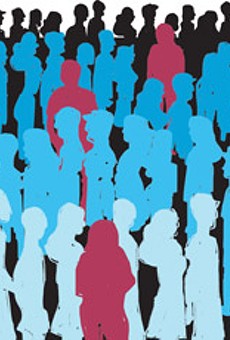The Greater Rochester area is full of smart, talented people. People who make this a great place to live. While it would be impossible to shine the spotlight on all of them, this project — the Rochester 10 — is designed to bring some of the hard-working background players in our local scene into the forefront.
We are in no way saying that these are the 10 (technically 11, as we're featuring one creative duo) most important people in Rochester. We're not even saying that they're necessarily the best at what they do. But every person on this list is contributing to life in Rochester in interesting, varied ways. One is responsible for booking some of the most interesting, offbeat music acts that come to town. One is helping to find shelter for our local homeless population. Another is creating low-cost, inventive dishes with a keen eye on alternative wellness, while one of our other selections has been instrumental to making Rochester a major site for H.I.V./AIDS vaccine research.
Read on to get to know these interesting Rochester residents. Is there someone else you think deserves to be profiled? Please add his or her name to the comments section of this article at rochestercitynewspaper.com for future consideration.
MUSIC: Tim Avery
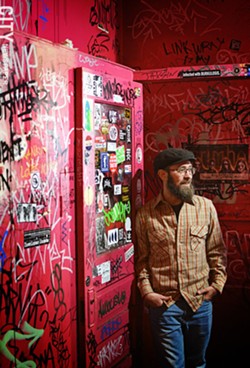
- PHOTO BY MATT DETURCK
- Tim Avery
You know the big names. The giant shows that come through — or skip coming to — one of Rochester's larger venues. The radio plays them. The Justin Timberlakes. The Jay-Zs. The acts that don't really need publicity to draw in huge crowds.
But what about the little guys? The bands starting out? The ones who drove for miles and are sleeping on friends' couches along the way? The ones that people haven't heard about yet? Who keeps an eye out for them? Who keeps the flow of new and upcoming bands coming into Rochester, while also helping to develop our own local music scene?
In Rochester, the man behind the beard, and behind that scene, is Tim Avery.
Avery got his start in the band The Kitchen Sinks. He bought a PA system and starting playing, and putting together, shows in unconventional (and often unlicensed) venues such as the AV Space, The Landfill, The Treehouse, and the Shark Tank. The shows, and the number of attendees, just kept growing.
It wasn't about the money — Avery says that he often lost money on shows. Instead it was about the community and the bands. "All I care about is awesome music, having a great time, [and] putting together the best bill possible," Avery says.
In 2009, the Bug Jar — one of the few venues in Rochester putting on live music events virtually every night — brought on Avery as a booking agent. Although the venue is more traditional (and legally sanctioned), Avery tries to keep it as much like a DIY venue as possible. It's not uncommon for Avery to open up his apartment to touring bands (a mattress is a permanent part of his living room), even occasionally cooking breakfast for the musicians who make Rochester just one of many stops of their touring lives.
There's also a business side to it, and Avery has to balance bringing in acts that he wants and likes with bands that will draw people in. And while Rochester has a reputation for being a big college town, it isn't quite that easy to get its spread-out, and mostly suburb-based, college populations into the city for live shows.
"We really aren't a college town in terms of music," Avery says. "You look at Buffalo. Why do Buffalo shows do so well? All those colleges are in the city. Those kids live in the city, they aren't afraid of walking at night, they are close to the venues, and they are bigger colleges as well." Avery says that a shuttle from colleges to venues during shows could help amend this problem.
There's still a lot of work to do to make Rochester's live-music scene viable. Avery points to Philadelphia as a city with a growing and robust scene. "Here, when I ask people what they are doing, it's either, 'I'm going out drinking,' or 'I'm watching my TV shows,'" Avery says. "We as a city consuming music and consuming art, we are at risk of becoming Kenny G fans. We are at risk of becoming McDonald's fans. We are at risk of becoming quietly irrelevant. And that, to me, is terrifying."
"We've got to get that kind of mindset into the population of Rochester," Avery says. "Choice A is go to shows, support the scene, start bands. That's what we have to be like if we want to blow up." — BY WILLIE CLARK
DANCE: Heather Roffe

- PHOTO BY JOHN SCHLIA
- Heather Roffe
Although a relatively small subsection of the arts, Rochester's dance scene is surprisingly vibrant. The well-regarded dance program at SUNY Brockport is an incubator for new talent. Internationally renowned troupe Garth Fagan Dance maintains its home on Chestnut Street. Myriad new, inventive troupes have emerged, dancing in wide-ranging styles. And opportunities like the multi-troupe Fabo Callabo, the Nazareth College Arts Center Dance Festival, and the Rochester Fringe Festival have given local dance groups high-profile opportunities to show their stuff.
Heather Roffe is connected to it all. She currently serves as assistant professor of dance at Nazareth College, where she is working to develop the dance minor into a full-fledged major. Prior to that she taught dance at Brockport, SUNY Potsdam, Wells College, and Hobart and William Smith Colleges. She is also a member of the dynamic FuturPointe Dance ensemble, a former member of Garth Fagan Dance, and guest performer in other troupes. And her inspiring original choreography has been performed nationally, and drew raves at the 2013 Fringe Festival.
But dance wasn't Roffe's initial career path. Although she has danced basically her entire life, she originally graduated college with a degree in business administration. Even as she worked in the marketing field, she taught dance in her off hours. "I woke up one day and the first thought I had was, 'I can't wait until this evening, to go work with my kids and teach them choreography,'" she says. "It made me stop and realize: What if that is what I do?"
A revelatory residency with the Limon Dance Company clinched the deal and she pursued her master's degree in dance. Since then she has worked as a dancer, a choreographer, and a teacher, all of which appeal to her in different ways. Finding a balance between the three takes effort, Roffe says, and that attention is clear in her work. As a dancer she is lithe and precise. Her choreography is fascinating to behold, shifting from style to style. The movements are sometimes so different that it seems impossible that they spring from the same mind.
That's intentional. "With each new piece I'm trying to say something new, and that often leads to a different movement that comes out of me," she says. "It's hard to say different things when you're using the same movement vocabulary."
Roffe's choreography explicitly tackles social issues. The 2010 piece "Text Me" deals with modern communication and how disembodied it has all become. The "Fear" suite, performed as part of the 2013 Fringe Festival, was inspired by the Trayvon Martin case.
For Roffe, dance "is my way of processing what is going on around me in contemporary society. Rather than stating my opinion, I look at it in an abstract way and let people take their own ideas and experiences away from the pieces," she says.
She continues to choreograph new pieces, dance with FuturPointe, and develop the program at Nazareth. Roffe says that the increasingly fertile local dance scene is a creative boon in many ways, especially when it comes to collaboration. But there is a catch.
"There's so much really interesting work happening here, which is great. But how do we get audiences to see it?" she asks. "We're all trying to find ways of collaborating and supporting each other, but we also need to find ways to distinguish ourselves."
"So much funding for the arts has been cut," Roffe says. "For small groups, grants are so competitive. Dance companies have to find a way to sustain ourselves."
But how do you do that? One answer may come in the way Roffe is constructing the dance program at Nazareth. In addition to training students in movement and performance, she's creating connections with the professional departments at the school, so that students learn massage, art therapy, and other skills that can help support them in their careers.
Roffe herself is currently reaping the benefits of a diverse education. "My business administration and marketing degrees are so helpful to have," she says. "A lot of skills are coming into play." — BY ERIC REZSNYAK
CULTURE: Gerry Hunt
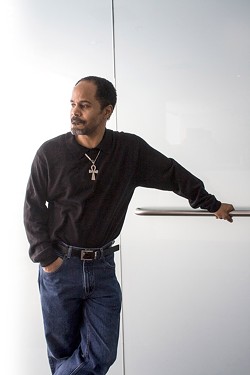
- PHOTO BY ASHLEIGH DESKINS
- Gerry Hunt
Georgia native Gerald Hunt, who heads up the Frederick Douglass Resource Center, became involved in the Rochester community through his father, Reverend Errol Hunt, who in the 1990's founded the Frederick Douglass Community Development Corporation. Reverend Hunt was the pastor of the Memorial AME Zion Church in Corn Hill. "When he arrived here, you had 'urban renewal' — vacant lots on either side of the church — so the neighborhood looked much different," says the younger Hunt. "His vision was to revitalize the neighborhood."
Gerald Hunt says that the black community of Rochester has been, and still is, "held in a socioeconomic oppressive condition." But he believes that creating a stronger black community with members who mutually lift one another is key. His father's FDCDC had three objectives. Phase 1 was to create safe, secure, clean housing opportunities for first-time home buyers. In conjunction with the FDCDC, 21 single-family homes were built in Corn Hill, "not exclusively for brown people," says Hunt, "but everyone who bought a house for the first time were black folks, young black folks, which was good to see."
Phase 2 of the objective is cultural education. This particular part seeks to supplement Rochester's urban education system, and to address our startlingly low graduation rates of black males. "I personally believe that the main ingredient, or component, that is missing or would make a direct impact in improving academic results is cultural education," says Hunt. This is where the Frederick Douglass Resource Center comes in.
While the majority of the students caught up in the Rochester City School District are children of color, says Hunt, "the entire scholastic paradigm is Eurocentric. That doesn't make sense." As a result, Hunt says there is a tangible "rejection of that paradigm by the students, and they check out. That's a direct result of looking in the mirror and seeing that-which-I-can't-be. Whereas, you have children come into the Center's library, and their eyes just light up. They see themselves," he says.
The Center, located on King Street, boasts a 130-seat auditorium with A/V capabilities and a gallery space that has hosted challenging exhibits of work by impressive young artists, as well as seasoned artists, such as Pepsy Kettavong. The Center has also hosted events to celebrate African and African-American heritage and culture, such as community forums, lectures by dignitaries such as Abiodun Oyewole of The Last Poets, political debates, African and African-American film screenings, plays, live bands, dancers, poetry, and even wedding receptions and baby showers.
Though Hunt heads up the Center, he says he doesn't receive compensation for his work there, and the board doesn't chase grants as a source of funding. "There's one more leg on the stool my father has, and that is economic development," says Hunt. "If the community is passionate about celebrating its culture, it should in fact support this cultural institution." Hunt says that it's not only feasible for the community to support important cultural endeavors, but that in the face of limited funding and competing institutions, it's critical for it to learn to do so.
"Rochester is rich in wealth. There are plenty of dollars in this community to run this center a hundred times over," he says. — BY REBECCA RAFFERTY
FOOD: Nick Bovenzi
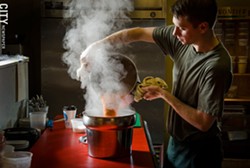
- PHOTO BY MARK CHAMBERLIN
- Nick Bovenzi
"I don't know if that's something that people should find out. It's really calculated."
That's Nick Bovenzi, chef at Natural Oasis on Monroe Avenue, and he's referring to exactly how much thought goes into the food he makes. Of course, any culinary professional worth his or her salt takes great care in the construction of a dish, but Bovenzi goes beyond technique and flavor to actually consider your body's reaction to Natural Oasis's vegan food.
"Vegetables and grains" is how Bovenzi accurately — if humbly — describes his ingredient options, yet the way he combines them, in concert with certain herbs and spices, is rooted in Ayurvedic medicine. So the next time you're savoring a delicious and inexpensive meal at Natural Oasis, please don't let Bovenzi know that you've learned how beneficial it is for you, otherwise we might both get in trouble.
The 33-year-old Rochester native made his bones under chefs like 2Vine's Jerry Vorrasi and Good Luck's Dan Martello. After a couple of unsatisfying stages in far-flung kitchens, Bovenzi returned home. In 2009 he approached Natural Oasis owner Solomon Kebede about expanding beyond the business's all-day Ethiopian buffet. The rotating, 13-item menu as we now know it debuted in the spring of 2011 with an emphasis on fresh ingredients, affordability (dishes generally cost $4), French technique, and healthful syntheses.
For Bovenzi, minimalism is key: "The pinnacle of cooking is to only have about four ingredients when you make something. If you can keep it simple on the plate, then people enjoy it and their body's not totally taxed having all this different food."
The kitchen at Natural Oasis is an open one, and it's not just to provide a focal point for the 30-seat dining room. "It shows the people who the chef is," he says, "and it gives you a chance to see the customer, too. Being able to see people while they eat is extremely important. If you look over and someone is kind of making a face, as a cook you know exactly what that face is. You can just pick it out, and you can attend to it immediately."
"They see me as I am, and I see them as they are," says Bovenzi. "It's really laid back."
Adding to that relaxed vibe is that unlike other restaurants, Natural Oasis, which also offers wellness products and services, doesn't rise and fall based on how many $4 dishes it sells. "There's about five ways the business brings in money," says Bovenzi. "The restaurant is only one of them. There's never that pressure, and it's a lot easier to make people comfortable."
Now, you won't find much information about Natural Oasis online, a rarity in this internet age, and Bovenzi is totally fine with that. "We're kind of outsiders," says Bovenzi. "We have a certain clientele, we have a certain product to put out, and we survive by meeting our customers and talking to them and being personable."
And just who are Natural Oasis customers? "Anyone can eat here," says Bovenzi. "I don't care if you're vegan, I don't care if you eat meat, I don't care if you're gluten-free; there's no excuse why you can't eat here except you don't want to. And if you don't want to, that's cool, too." — BY DAYNA PAPALEO
EDUCATION: Caterina Leone Mannino
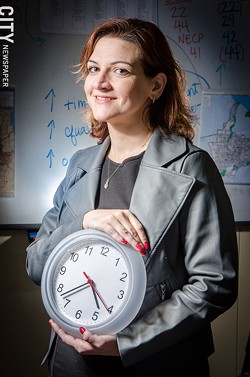
- PHOTO BY MARK CHAMBERLIN
- Caterina Leone Mannino
When Rochester schools Superintendent Bolgen Vargas began developing his concept for expanded learning about two years ago, he turned to Caterina Leone Mannino, the district's director of school innovation.
Though somewhat controversial and difficult to implement, expanded learning can give students and teachers more time for instruction and extracurricular activities such as music, arts, and sports. But it is an enormous undertaking. The schedule changes can be stressful for students, parents, and teachers. And the results are not immediate.
Students in more than 20 city schools now have longer days. And Mannino is charged with overseeing their progress, interacting with the state Education Department, and researching successful models around the country.
It's a high-pressure position for the 20-year veteran of the education field, and a lot is at stake. Vargas has made expanded learning the foundation of his strategy to fundamentally transform the struggling school district.
Mannino joined the Rochester school district in 2003, and she's spent much of her time working on language and literacy development. It's an especially important issue for city students, she says, since many enter school with serious deficiencies.
"Teaching reading is not really about teaching kids to recognize a word," she says. "It's about teaching them how to interpret the world around them. Reading is the key that unlocks everything else."
Improving urban education is essential to breaking the cycle of poverty that snares generations of families in Rochester and in urban districts across the country, she says.
Mannino, who is the first member of her family to graduate from college, tells students that it's O.K. to struggle with something that's hard to do.
The worst thing teachers and parents can do, she says, is pity city students because they face so many hardships and excuse them from doing the hard work it takes to be successful.
"So many of our kids have made it through obstacles many of us can't even imagine," Mannino says. "So how do we work with those strengths and that resilience that sometimes even they don't realize they have? How do we put them on the path of lifelong learning?"
Mannino stays in contact with some of her former students in Boston where she began her career. And she insists that teaching, despite the current tumultuous atmosphere in the education field, is still one of the most important and rewarding careers anyone can pursue.
"You have to go and look back at the classroom and remember that you're making a child's life better," she says. "We hear only about the district's failures, but challenge is an opportunity."
Mannino says the public is beginning to recognize that good schools and teachers are only a part of the solution to improving education. Schools, affordable housing, and health care are interrelated, she says.
"We're pushing boundaries out of our comfort zones," Mannino says. "How do we bring all of these resources in Rochester together? How do we build these relationships? That's what we need to focus on." — BY TIM LOUIS MACALUSO
MEDIA: Carvin Eison
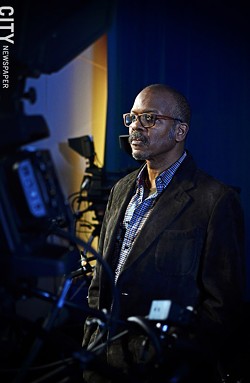
- PHOTO BY MATT DETURCK
- Carvin Eison
Carvin Eison believes in the power of media.
He's spent 40 years producing films and television programs that tackle a variety of subjects. He's served as a videographer for Garth Fagan Dance, produced a current affairs program, and recently released a film, "Shadows of the Lynching Tree," that examines the history and lingering impacts of lynching in America. He worked at WXXI for 10 years and was also part of the team that produced "July '64," a 2004 documentary about the 1964 race riots in Rochester.
But Eison is also educating the next generation of producers, all with their own ideas and messages to broadcast. He does that in the classroom as an associate professor in SUNY Brockport's Communications Department and in the community as general manager of Rochester Community Television, a job he's had for 10 years.
"I think in this modern world everyone ought to be able to produce pictures and sound in a credible way to send a message," he says.
And community television provides a platform for the public to do that, which is what he says he finds attractive about it. Community television gives people a voice, he says — one that enables them to create programming focused on life in their community.
A fundamental desire to ensure that people are media-literate is at the core of Eison's educational efforts. He says he wants to make sure that people understand how messages are constructed and how they are designed to persuade.
At RCTV, his focus has been on improving the quality of programming — a task that's part technical, part conceptual. He ensures that the station provides the public with equipment capable of producing high-quality audio and video. He also works directly with producers to help them refine their messages and to develop compelling productions. The latter is all about getting people to think about what they want to say in a visual medium and how to do it clearly, he says.
Eison is using his latest film project to teach documentary work to some producers. The project, which he's calling "July '14," is a follow-up to "July '64." It'll look at where the City of Rochester is in terms of health, education, and employment 50 years after the 1964 riots.
"I feel that I have maybe two, three more big films to do if I'm lucky, but I want to teach other people so that tradition can continue on," Eison says. — BY JEREMY MOULE
ACTIVISM: Ryan Acuff

- PHOTO BY GERRY SZYMANSKI
- Ryan Acuff
Some of Rochester's homeless have traditionally sought shelter in the Civic Center Garage downtown. But the garage's management wants them out.
Local activist Ryan Acuff says the firm should back off until some sort of contingency plan is in place.
The garage management — and the public for that matter — can't arrest its way out of the problem, he says. Homelessness is a symptom of larger issues around housing, Acuff says, including an insufficient shelter system. Fundamentally, he says, everybody is entitled to a place to live.
"There shouldn't be anybody out in the cold in a county as rich as this one," he says.
Acuff is a familiar figure in local activist circles. He was heavily involved in Occupy Rochester and is active with local police accountability groups and Genesee Valley Earth First. He also serves on the board of the Genesee Valley chapter of the New York Civil Liberties Union.
But a lot of his time is spent on housing issues.
Acuff is an advocate and case manager at the House of Mercy shelter. It's through that job that he's become involved in the Civic Center Garage issue.
House of Mercy also works with St. Joseph's House of Hospitality and St. Mary's Parish on a Housing First initiative. The homeless are given a place to live and then paired with the services they need.
Acuff is also heavily involved with Take Back the Land, an activist group based on the concept of housing as a human right. The local group has made a name for itself fighting against what it considers to be unjust foreclosures, winning a few high-profile battles over the past year.
Take Back the Land organizes and joins with community members to resist evictions. Efforts often include a literal human blockade.
Last month, on the heels of one such effort, a southwest Rochester woman's house was deeded back to her by the bank.
Take Back the Land's approach draws attention to larger moral and ethical issues raised by some foreclosures, Acuff says. In particular, group members want the public to know when big banks — the ones that were bailed out by the government — kick people out of their homes, he says.
But the group does something else that receives less public attention; it locates vacant, bank-foreclosed houses that it can move homeless people into.
"We think the homes should be lived in while people are homeless, living on the street, living in shelters," Acuff says. — BY JEREMY MOULE
MEDICAL: Dr. Michael Keefer
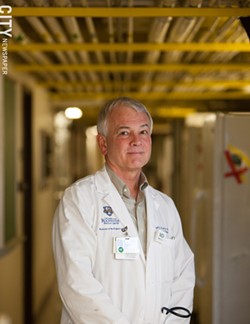
- PHOTO BY JOHN SCHLIA
- Dr. Michael Keefer
Earlier this year, the National Institutes of Health named the University of Rochester a Center for AIDS Research. The designation came with $7.5 million for H.I.V./AIDS research, and elevated the UR to the national stage when it comes to finding treatments and prevention routes for the disease.
The competition for the CFAR designation is tough and only universities that already have considerable funding and research under way are seriously considered. The UR is now one of 18 CFAR institutions in the United States, and some of the credit for reaching this important milestone goes to Dr. Michael Keefer.
Keefer is the director of the UR's H.I.V. Vaccine Trial Unit. He's been working on the search for an effective vaccine for much of his career.
Prior to the UR's CFAR designation, Keefer was the associate director for the administration of the H.I.V. Trials Network — monitoring a global effort involving multiple trials.
There are many forms of H.I.V./AIDS research, and they tend to generally fall into two categories: treatments for people who are already living with H.I.V. or AIDS, and prevention to stop the virus or the disease from spreading.
Keefer, who has consistently been one of the area's most accessible authorities, says enormous progress has been made over the years in treating people with H.I.V./AIDS. People are living longer.
And while the immediate goal used to be extending a patient's life, research has now turned to understanding how H.I.V. impacts the aging process.
Even though proper use of condoms is a highly effective way to prevent the spread of H.I.V., Keefer says, changing human behavior is not easy. So the hunt for a vaccine that prevents the contraction of the virus is still a critically important goal in the global medical research community. And Keefer has been instrumental in those efforts.
Vaccine trials, which have been under way around the world for years, require long and complicated studies before human trials can begin. And Keefer has had his hopes dashed more than once.
"We're getting closer and closer," he says.
Many Rochesterians have probably seen posters from Keefer's department promoting awareness about the UR's trials and seeking local volunteers for them. The posters appear throughout Rochester — from coffee shops to college campuses.
Keefer says the first generation of vaccines may not work 100 percent of the time or may require use in combination with another medication.
"There's now more realistic talk of cures and visualizing a way to do this," he says.
Though Keefer is passionate about one day seeing H.I.V./AIDS eradicated, his career almost took a different turn. He earned his undergraduate degree in zoology at Miami University.
"I thought I wanted to be a veterinarian," he says.
But he went to medical school instead, at a time when interest in infectious diseases was picking up because of the emerging AIDS epidemic.
"It all just came together for me," Keefer says. — BY TIM LOUIS MACALUSO
POLITICS: Christine Christopher
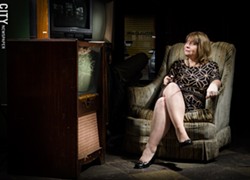
- PHOTO BY MARK CHAMBERLIN
- Christine Christopher
Though she worked as Geva's public relations director for a time, Christine Christopher says she had to take a job with state government to learn what drama and bad acting is really all about.
"It was like a whole different world," she says.
Christopher's career has taken her from the theater, to the state capitol as a legislative and media aide to Assembly member Susan John, to a Ku Klux Klan rally in northern Louisiana — as a filmmaker, not a participant — to a play date with future A-lister Josh Brolin. (A young Brolin visited her home while he was doing theater at Geva.)
"It sounds glib, but I really mean it with my whole heart," she says. "I'm so lucky that so many interesting people have offered me so many interesting things to do."
And Christopher will take on another new role in January when she becomes the City of Rochester's director of communications.
Christopher is a graduate of Fairport High School and currently lives in the Highland Park neighborhood in the City of Rochester. She owns the marketing and public relations agency Christopher Communications and is a co-producer and writer for the nonprofit Blue Sky Project. Blue Sky creates and distributes documentary films "focused on underreported social issues," according to the organization's website.
Christopher estimates that through her company she has worked on at least 50 political campaigns over the course of her career. Her role with each campaign varies according to need, she says, but she is usually a strategist.
Christopher was most recently communications chief for Lovely Warren's successful and historic campaign for Rochester mayor. Warren will be the city's first female mayor, as well as its youngest when she takes office in January.
"For me, this was not another job," Christopher says. "I really feel that something incredible was accomplished. I just really believe in her and really believe in the direction she wants to take the city.
"I feel that she has a way of inspiring people who need a dose of optimism in their life," she says. "And when you look at Lovely and her life, it makes people think that they can be better."
Christopher says she chooses projects based on what moves her. And it's clear that her experience making a documentary on the 1971 Attica prison uprising was profound, even life-changing.
"Criminal Injustice: Death and Politics at Attica" focuses, Christopher says, on the politics behind the aftermath of the uprising and the retaking of the prison.
The documentary has provoked a significant response, she says. It has also, she says, cast doubt on the official story behind the death of prisoner L.D. Barkley.
Barkley, a Rochester resident and iconic face of the uprising, died during the retaking of the prison. Blue Sky's documentary questions the official story, that Barkley was killed by a ricocheting bullet.
"I learned that things are not always the way they seem," Christopher says. "That you really do need to challenge and ask questions, even 40 years later.
"It was a very profound experience and one that I don't think I'll ever set aside," she says. — BY CHRISTINE CARRIE FIEN
ENTREPRENEURSHIP: Ajani Jeffries & Josiah Montalvo
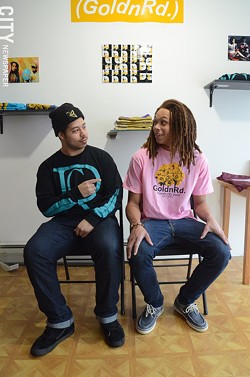
- PHOTO BY LARISSA COE
- Josiah Montalvo (left) & Ajani Jeffries (right)
Over the past few years, the emerging generations' tone toward Rochester has shifted from one of defeated apathy toward one of adoration and faith and initiative. There is more vocal support for local businesses and creatives, and more pride in Rochester in general. Among the creative youth who are forging their own local-pride-path are Ajani Jeffries and Josiah Montalvo of Goldn Rd. The young entrepreneurs' skateboarding-culture-influenced clothing company features a variety of strong, simple graphics, often with a colorful, cheerful nod to Rochester's iconography, such as a branch of lilacs.
Jeffries and Montalvo are both from Rochester — Jeffries is from the west side, and Montalvo is from the east side of the city. They met in the 7th grade while attending the School of the Arts, from which they graduated in 2011. It was there that Jeffries and Montalvo became interested in designing and selling clothing, beginning by stenciling t-shirts "which created a big buzz in school," says Montalvo.
The pair gradually evolved their business into Goldn Rd., taking the name from a misheard lyric in Jimi Hendrix's song, "One Rainy Wish." But the name also contains religious allusions, and nods to the golden road of success, says Jeffries. "We told ourselves in the beginning, 'Let's just try to have fun with this project, and be as creative as possible,'" he says.
Jeffries and Montalvo create their designs on a computer, and tweak images for printing with the help of Evan Guerin of Galaxy Graphics, where Goldn Rd.'s goods are screen printed. They try to release new clothing lines for each season, just as it's done in the international fashion world. "But it's also based on the money in our pockets," says Jeffries.
Jeffries and Montalvo are both employed at pizza shops at the moment to supplement their income, and are saving up to purchase sewing and embroidery machines and screen-printing equipment of their own. "We know how to do everything, we just don't have the equipment," says Jeffries. They plan to expand their currently offered range of shirts, tank tops, hoodies, sweaters, and beanies, to include other items, such as flannels and jeans.
In the past, the clothing has been offered at Krudco Skate Shop, a natural connection since Goldn Rd. sponsors skateboarders and other artists with free clothing and by publicly supporting them in what they do. But Jeffries and Montalvo recently began renting their own space at 159 Caroline Street, where they host pop-up shops.
Jeffries and Montalvo are also in the midst of planning the Goldn Rd. 5K, set to take place on June 22 at Cobb's Hill Reservoir. They're currently working on gathering partnerships with indie businesses in Rochester, and plan to use the event to build awareness and support for the in-development Roc City Skate Park. "Our goal is really to bring light to Rochester, to promote this place and its people," says Jeffries. "We want to be one of the reasons people here get exposure outside of the city." — BY REBECCA RAFFERTY

